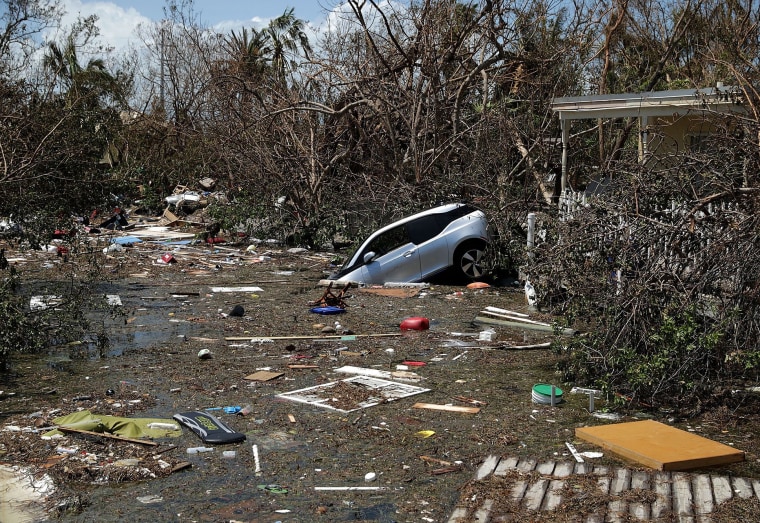The United States dodged a bullet with Irma, but experts say that’s no reason to celebrate. The storm blew itself out before living up to its status as the storm of a lifetime for the state of Florida, but Irma’s sheer size meant that a wide swath of Florida, not to mention Georgia, Alabama, and South Carolina weathered its wrath.
And the fact that this storm did so much damage even though this wasn’t the “big one” is discomfiting to experts.
“The scary thing to me is that this wasn’t really a strong storm I’m really frightened about what happens when there is a direct hit,” said Karen Clark, co-founder and CEO of disaster modeling firm Karen Clark & Co.
While Clark’s company estimated that a wind-driven direct hit on Miami would have served up catastrophic $150 billion in insured losses, the storm veering off the the west saved Southeast Florida from the most apocalyptic scenario, but this came at the extent of immense devastation in the Keys as well as unexpected flooding in places like Jacksonville along the Atlantic coast, where a combination of heavy rain and storm surge filled homes and businesses that had only just begun to recover from last year’s Hurricane Matthew.
Related: Irma Brings Fear for Florida's Farmland
Clark & Co. estimated that insured losses for Irma total $25 billion, with the U.S. and its territories accounting for about $18 billion of that, and Florida making up about 90 percent of that total.
“The loss is really a loss all over the state,” she said.
Clark said her firm hadn’t yet extrapolated Irma’s total economic footprint, since the extent of the damage in some areas is still unclear, but historical norms from similar storms where wind did more damage than floodwaters indicate that total damage winds up being around 1.5 to twice as high as insured losses.
Using this kind of calculation on Clark’s initial insured-losses estimate, Irma could cost the U.S. around $35 billion.
Moody’s Analytics estimates that the total economic loss from Irma is roughly $70 billion, including property damage and the short-term loss of economic output. About half of that total is due to damage to residential real estate, and vehicle damage added up to roughly another $4.5 billion.
Moody’s estimated that Irma caused between $5 billion and $9 billion in commercial and industrial real estate damage. Big buildings in Miami got by mostly unscathed, plus the region has less industrial buildup than Houston, which was ravaged by floods from Hurricane Harvey.
Florida’s $8 billion agriculture business, while not as severely impacted as initially feared, still suffered damage, with Moody’s estimating a roughly 12 percent drop in citrus production and a 10 percent falloff in the sugarcane crop. According to commodity trading consultant Mike Seery, the state’s cotton crop and cattle production escaped serious damage. A related wrinkle that could put a drag on the agriculture sector’s recovery, Moody’s found, is that much of the temporary housing where seasonal farm workers are lodged was destroyed or damaged, making these accommodations scarcer.
A Stalled Economy
About 20 percent of the total, or around $14 billion at the middle of the estimate range, is comprised of lost economic output. Compared to Harvey, said Moody’s analytics chief economist Mark Zandi, “Economic disruption was greater because of power loss and disruption of the tourism industry, which is vital to Florida.”
Insurers and individuals alike are breathing a sigh of relief that Irma spared the major metro areas of Miami and Tampa. Catastrophe modeling firm AIR Worldwide calculated the value of exposed property along Florida’s Gulf Coast up to Tampa at a whopping $1 trillion, while an early estimate based on last week’s prediction of an easterly track for Irma from real estate analytics firm CoreLogic said as many as 8.5 million homes and businesses were at risk of sustaining wind damage from the storm.
In reality, the hurricane’s ultimate trajectory led to a less severe, but broader impact throughout the state.
“The interesting thing about Irma is it was such a widespread storm, it really impacted most of Florida,” Clark said. “Hurricane-force winds extended out 80 miles from the center, so low-level wind damage is going to be everywhere.”
Evacuees Filled Hotels
Again, it could have been much worse. September is a historically slow season for tourism in the state, and the losses from people canceling hotel stays was partially offset by people evacuating in advance of the storm and filling up some of those rooms. The Orlando area, which draws about half the state’s tourism business, was spared the worst of both the winds and the rain.
Moody’s estimates that Irma did more damage to infrastructure in Florida than Harvey did in Texas, primarily because of widespread power outages and damage to water and sewer lines, impact that could collectively total around $10 billion.
An estimate published Monday by AIR Worldwide came in with a third set of figures, saying that Irma could cause insured losses of between $20 billion and $40 billion, based on the current storm track and National Hurricane Center forecast as of Sunday evening.
Related: How to Help After Hurricane Irma
“People throw around a lot of numbers in the beginning of these disasters,” said Amy Bach, executive director of the nonprofit group United Policyholders. “Almost always, the numbers go down.”
But while that might be good news for insurers, it’s not necessarily good for homeowners and businesses. “It’s just that the industry has been trimming, trimming, trimming coverage for the past 15 years,” Bach said. Often, those estimates of insured losses go down not because the weather was less severe than feared, she said, but because insurers pay out less than they anticipate.
“The real people we should be worrying about are the people who bought coverage and are going to find that coverage is not going pay for all of their repairs,” she said. “We certainly hope people’s policies are going to deliver.”
